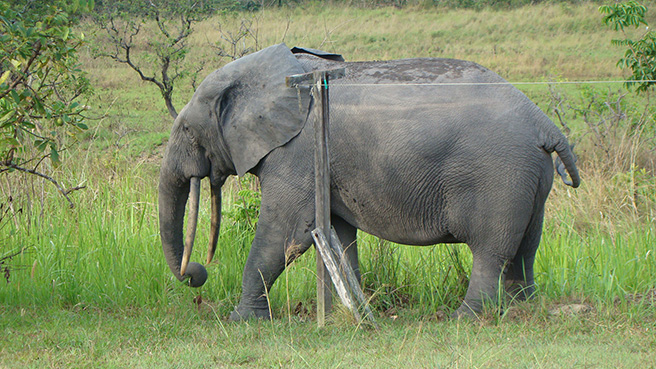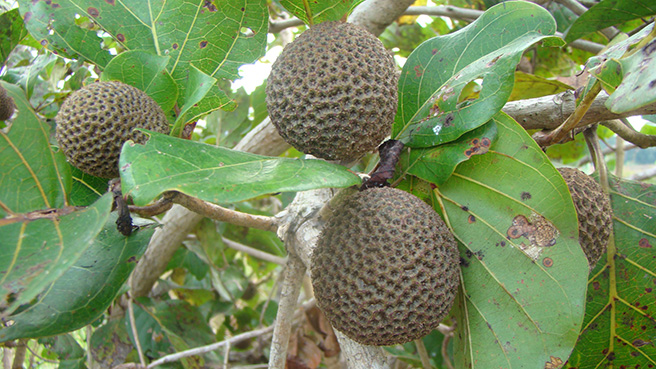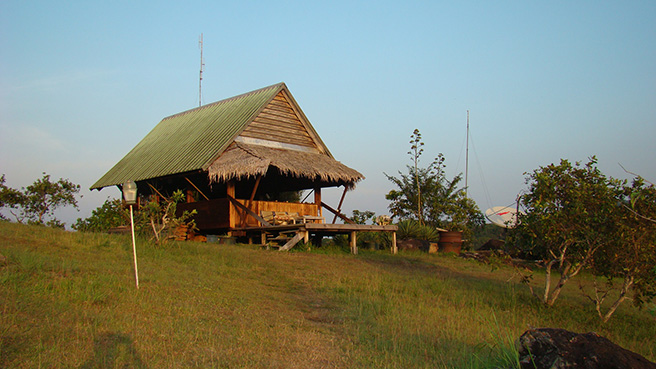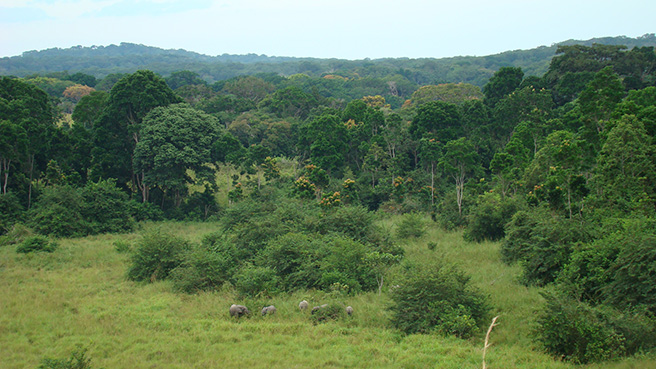Elephants of Central Africa: Giants in the Dark

Nighttime in a Central African forest reveals a suite of completely new, mostly acoustic, experiences from the day.
Sleep is often interrupted by the clamoring within chimpanzee groups and the screams of a tiny primate, the bush baby (which gets its name from sounding like a baby crying), all above the drone of the regular nocturnal insects and frogs. But nothing is more remarkable than the forest elephant because night allows one the rare opportunity to experience them closely. Feeling protected by the cover of darkness and the absence of humans, they forage right next to inhabited cabins.
I was studying African forest elephant social structure at the Station D'Etudes des Gorilles et Chimpanzes, a field station developed for primate research in the northeastern section of Lopé National Park, Gabon. African forest elephants are a separate species from the well-known savanna elephants of Eastern and Southern Africa. They are less accustomed to tourism and therefore much more elusive than their sister species. In Lopé, with the exception of two males named Billy and Senegal, elephants visit the field station exclusively at night. They are attracted to the mowed lawn surrounding the field station, which serves as a constant source of soft, palatable grasses, in addition to several preferred fruiting trees on site.
Outside my window was a Nauclea diderichii tree, a tree bearing one of the forest elephants’ favorite fruits. When night falls, the elephants slowly emerge from the forest surrounding the field station and crunch loudly on these brown, orange-sized fruits. On nights with full moons, the sky becomes lit, enabling you to see the elephants in detail. Standing behind my window, only a screen, a few planks of wood, and approximately three feet of space separated me from these multi-ton animals. Their gray skin, dry and ridged, would glow in the moonlight; the gentle sounds of huffing and swishing as they pulled grass with their trunks made them sound almost like giant horses grazing in a field.

One night, something deviated from this typically serene event. I was awakened by elephants, but could immediately sense they were behaving strangely. From my bedroom I listened as they moved brusquely about the station. I heard the splitting and tearing of branches as they were ripped off fruiting trees and the clatter of garbage cans being broken into. Although this behavior wasn’t normal at Lopé, it was not outside the realm of elephant behavior. After an hour, the elephants were still circling the main building of the station. It was then that I heard something distinctly unusual: the sound of breaking glass. The elephants were breaking the windows of the main building.
The ruckus of the agitated elephants continued around the site, and it had been nearly two hours since I was first awakened by their presence. It was at this time that I heard the unnerving sound of the elephants closing in on the cabin I was in, which consisted of four bedrooms and a bathroom. The twisting sounds of metal pipes being bent and the dull thumping of their bodies against the wooden walls indicated that they were breaking into the bathroom. Outside of my room an elephant tried to climb the stairs leading up the front porch. It pushed my door in with its trunk, but the door held, luckily, being locked from the inside.
The thumping was approaching my bedroom walls, and the reality of the flimsy planks of wood standing between the several highly agitated, multi-ton elephants and me suddenly closed in. I decided it was no longer safe to stay in bed. I leapt out of bed to the opposite side of the room. There was no time to grab a flashlight and the moon was dull, so I only saw darkness. I heard wood breaking and falling, but the noise was coming from inside my room. There were two other researchers in the rooms next to mine and I called out “They’re coming in my room!”
One of the researchers answered back and we decided I should move to his room. I listened carefully outside my door to make sure no elephants were there and quickly snuck into the room next to mine. The researcher didn’t have a flashlight so we lit a candle. As we were whispering what to do, the elephants indicated their displeasure with several rumbles (deep growling noises) and trumpets. We blew the candle out immediately to try to appease them. A few seconds afterwards one of the elephants let out a long, deep rumble. We remained quiet, frozen in place, and then after a minute, they finally left for the night.

The next morning we surveyed the damage. They broke several windows including the panels and screens of mine, tore the shower curtain and rod off, pulled on pipes, and pulled items out of rooms. In the history of the field station’s 25 years, elephants have never tried to break into any of the buildings. There didn’t seem to be any patterns. If they were interested in food, they would have spent more time in the kitchen or have tried to break into the pantry. Elephants can also be interested in scents, for example those in shampoos or soaps. Although they tore into the bathroom, they didn’t ingest or open toiletries, and seemed to be equally destructive around the rest of the field station. While I don’t know why this particular incident happened, I do know that the elephants in Lopé are aggressive. When walking in the Lopé forests, guides stop frequently, listening and smelling for signs of elephants, and anticipating charges around every bend in the trail.
Hypotheses about aggression in elephants in Lopé center around the park’s history in poaching. As Lopé elephants have been poached heavily in the past, and although they are still poached, threat has alleviated in the northeastern section of the park because of research and tourism (although this currently may longer be true). Elephants may have become more aggressive as they still associate humans with poaching, but are less fearful and now stand their ground, a behavior also observed in gorillas. Another hypothesis is that many of the Lopé elephants may have lost their mothers to poaching when they were younger, and were exposed to the trauma and/or may not have been properly raised. For example, in savanna elephants, when only younger males were relocated to a park in South Africa, they began killing rhinos. Adding older males to this population ended this because they were able to suppress the hormones causing these behaviors in the younger individuals (Slotow & van Dyk 2001).
Regardless of the reason for aggression, poaching is a severe threat not only to elephant numbers, but also elephant society. In savanna elephants, populations that have been poached have higher stress levels, lower numbers and survival of calves (Gobush et al. 2008), and are less able to effectively respond to the calls of predators such as lions (McComb et al. 2011). These groups usually lose the matriarch of the family, which is the eldest female and desirable for poachers because tusks grow larger with age. As elephants are long-lived species, and have good memories, losing this individual affects the whole group, as generations’ worth of knowledge about the ecosystem is lost.

Poaching has reached its highest levels in recent years because demand for ivory is increasing, especially as more people moving into the middle class in China and are able to display their wealth with ivory statues or jewelry. Although my night with the “crazy” elephants was the scariest moment of my life, I respect the elephants and advocate for their conservation. Previous to my research in Gabon, I worked in Kenya for a year. There, I was able to see some of the most tolerant elephants in the world in Amboseli National Park, Kenya, where they have been exposed to tourism on a daily basis and have been researched for over 30 years. These elephants are so easygoing that you can park your car right next to a group and they will remain there, casually eating, so close that you can almost reach out and touch them.
The elephants are merely responding to the situation they are in, and their situation is becoming progressively worse. Even the Amboseli elephants are no longer immune to the effects of poaching with several having been killed this year. The demand for ivory has become so high, that 62% of all forest elephants have been lost in only the short period of 2002-2011 (Maisels et al. 2013). The methods of poaching have also exacerbated. Now elephants are killed by well-regulated militia with AK-47s and poachers closely tied to terrorist organizations. With elephants living in such a heightened and violent state, their only hope for survival is to run, hide, and fear people if we are not there to protect them.
Learn more about AWF's work with the forest elephant.
Gobush KS, Mutayoba B, Wasser SK (2008) Long-term impacts of poaching on relatedness, stress physiology, and reproductive output of adult female African elephants. Conservation Biology 22, 1590-1599.
Maisels F, Strindberg S, Blake S, et al. (2013) Devastating decline of forest elephants in Central Africa. PLoS ONE 8, e59469.
McComb K, Shannon G, Durant SM, et al. (2011) Leadership in elephants: the adaptive value of age. Proceedings of the Royal Society B 278, 3270-3276.
Slotow R, van Dyk G (2001) Role of delinquent young "orphan" male elephants in high mortality of white rhinoceros in Pilanesberg National Park, South Africa. Koedoe - African Protected Area Conservation and Science 44, 85-94.
